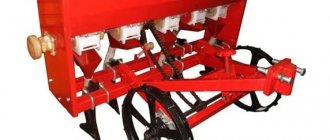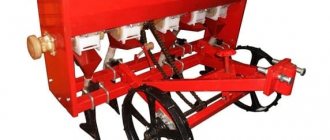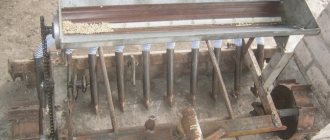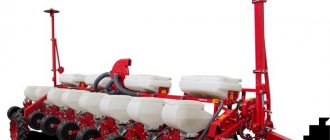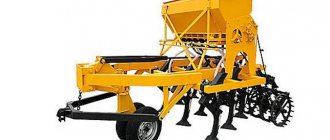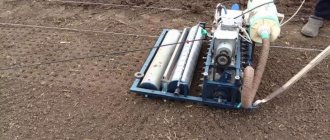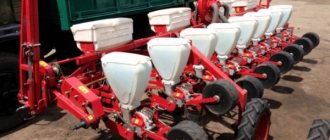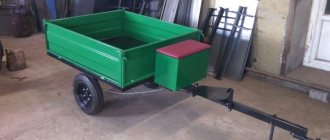In agriculture, there is a wide range of work that must be performed both every day and seasonally. So, you have to work almost around the clock.
But, fortunately, modern progress helps farmers and makes their work much easier. After all, now almost all processes are replaced by machine labor.
Traditionally, one of the most labor-intensive and time-consuming tasks is the process of sowing various crops.
After all, for this you need not only to scatter the seeds, but also to properly prepare the soil. One of the common crops that is planted every year is garlic. So, in order to make the process of sowing garlic as simple and convenient as possible, you can use a manual garlic seeder and a precision seeder.
Device
With this unit, you don’t have to worry about not having enough time or energy to sow. After all, the technique is really effective and will allow you to significantly reduce the time for sowing. You can also use a lawn seeder here.
The operation process and design of this device are quite simple. So, the main working parts, such as a container, a gearbox, and a sprocket connected by a chain, are installed on the frame. To ensure that the garlic cloves are distributed evenly and in a single layer, the device is equipped with special discs.
To make it as convenient as possible to transport this structure during operation, it is equipped with a wheel at the front. Most often, such units have only 1 part for movement, but some are equipped with 2 wheels. For the sowing process, the cloves are poured into a container, after which they are evenly distributed over the ground.
Thanks to such a thoughtful and, at the same time, simple design, you can easily complete a large amount of work that would be done manually by about fifty people.
The garlic seeder is really quite effective and certainly very useful in working on the farm and in agriculture.
For more information about the operation of the garlic seeder, watch the video:
A seeder for garlic bulbs will become an indispensable assistant.
Possible problems
Attention!
The device has its own characteristics, so if you have not previously had experience assembling a garlic seeder according to a drawing with your own hands, the task may seem difficult. Follow the instructions carefully.
To create a garlic seeder for a walk-behind tractor, you will need a welding machine and the ability to use it.
Observe safety precautions when wearing:
- work gloves;
- boots;
- protective clothing and mask.
Since the planter is heavy, it may tip over. To avoid problems, weld a counterweight to the device and work together.
A garlic cutter is indispensable when working on a large farm. To choose the right type, you should pay attention to the type of seed, the condition of the soil and your capabilities. The garlic cutter will help you grow a rich harvest and will last for more than one season if used carefully.
Models
There are a variety of models of agricultural seeder for planting garlic. Let's look at the most common options for seeders for farmers.
To the walk-behind tractor
Garlic seeder for walk-behind tractor. Since machinery is actively used on the farm, walk-behind tractors have become one of the most popular types of transport, which, moreover, is ideal for working in the garden. As a walk-behind tractor, you can use the models Beam, Tarpan, Oka, Mole, Bison.
Therefore, if the soil on your site is not very convenient for transporting the seeder manually, or you simply want to save time, then it will be much more convenient to attach a device for sowing garlic to a walk-behind tractor. This is done thanks to special fasteners or adapters.
By clicking on the link here, you will get acquainted with the malfunctions and repairs of the Texas cultivator, which is very popular nowadays.
A household grain crusher is your reliable assistant in the household. With it you will quickly and efficiently grind various grain crops.
With a walk-behind tractor cart, you will transport a lot of different loads on your site and do a large amount of work.
As a rule, the seeder is set to a certain operating mode, after which the walk-behind tractor transports it along the entire planting line so that the bulbs get into the ground. This method is the fastest and most convenient, however, it requires fuel costs for the walk-behind tractor.
Manual
A manual seeder is simpler and requires manual adjustment and transportation. As a rule, such units are in demand among owners of small plots, as well as among those who want to use equipment in agriculture as economically as possible.
Of course, you will need more time to carry out the work than when using a walk-behind tractor.
Four-row
The four-row seeder is also very common in agriculture. A distinctive characteristic of this unit is that this type of equipment allows for sowing as accurately as possible, in 4 rows. Thanks to this, you will not have problems with spot landing.
In addition, you can sow bulbs of various diameters. This technique is convenient, allows you to work in a wide variety of areas and do it really effectively.
If we talk about purchasing such equipment, you need to be aware of the cost. Depending on the type of device, prices vary. So, a seeder for a walk-behind tractor can cost you about 300 USD, manual equipment will most likely cost no more than 150 USD, and a four-row seeder can be purchased for 200 USD.
Used equipment can cost about 20% less than new ones.
The average technical characteristics of walk-behind seeder models can be described as follows. They can have 2 or 3 rows, which allows you to sow different sizes of seeds and do it quite quickly. The calibration of the teeth can vary from 10mm to 30mm.
The productivity of the equipment ranges from half a hectare to a hectare. The weight of such devices starts from 40 kg. As a rule, the row spacing and planting depth depend on the specific model of the unit. The bins hold approximately 10 kg.
In which stores and for how much can you buy it?
- The Tiu.ru marketplace offers hand planters starting from 10 thousand rubles. The cost of devices for a walk-behind tractor starts from 20 thousand, each additional row adds 10 thousand to the price. Six-row planters for tractors cost from 60 thousand rubles. The cost of delivery to Moscow and St. Petersburg depends on the seller. Free delivery and pickup are available.
- The agricultural equipment store Garden-shop sells planters for walk-behind tractors for 20-25 thousand rubles and more. Prices for tractor devices are set in the region of 40-50 thousand rubles. Delivery to Moscow and St. Petersburg costs 1 thousand rubles. If the address is outside the city, 40 rubles/km in the Moscow region and 35 rubles/km in the Leningrad region are added.
- The equipment store 100kwatt.ru sells planters for walk-behind tractors starting from 20 thousand rubles. You can buy a device for a tractor for 40 thousand or more. The cost of delivery also depends on the specific product and the place of acceptance.
- The Agrotrade store sells three-row garlic planters for 100 thousand rubles and four-row ones for 200 thousand rubles. Delivery is discussed with the store manager and depends on the weight, dimensions and city of the buyer.
With your own hands
In order to make a garlic seeder with your own hands, you need to acquire specific drawings and spend a couple of days at work. You will need the following parts:
- Container box for garlic cloves;
- Rotating shaft;
- Brushes for regulating the seeding flow;
- Wheel;
- opener;
- Pens.
The principle of operation of the unit is simple: you must ensure a uniform flow of cloves in a certain mode.
To do this, use a box with a double bottom in which a metal movable plate is inserted. The holes at the top and bottom match.
The movement of the plate regulates the flow, resulting in a normalized flow of garlic cloves outward.
Assemble a garlic planter for a walk-behind tractor yourself
You will have to copy the finished design and simplify it. The principle of the device is simple. The keeled coulter rake the soil and create a furrow. During one revolution of the wheel, several pieces of seeds are alternately fed. The hiller rakes up the soil and fills in the garlic.
The difficulty lies in creating a seeding flow mechanism. The chain version is difficult to manufacture. You will have to purchase separate parts: wheels, shaft, special brushes. The feed of the teeth will have to be adjusted experimentally. Install an impeller in the conical hopper and coordinate the rotation with the movement of the sowing device wheel.
Related video: Garlic cutter
Publications on the topic
Motoblock "Neva" and attachments
Homemade blade from a walk-behind tractor
Operating rules and technical characteristics of the Cascade walk-behind tractor
The best seeders for a walk-behind tractor and how to make a planter with your own hands
Many farmers ask how to make a seeder for a walk-behind tractor. In modern agriculture, motor cultivators are increasingly used, which include various devices and designs. Such tools also include grain seeders mounted on a walk-behind tractor.
The seeder for the walk-behind tractor is designed for uniform distribution of cultivated seeds in the ground. The type and type of structures resemble tractor ones, only several times smaller.
Appearance and principle of operation of the device
The manual garlic planter is designed to make the planting process easier, save time and improve quality by evenly distributing the cloves throughout the area.
The basis of the equipment is a metal frame with long handles, on which a sprocket, chain, gearbox and container for laying seed are attached. The planter is equipped with iron discs that distribute the seeds evenly along the entire length of the furrow, and mounted blades that cover the tines with soil.
In the process of moving from the wheel on which the sprocket is attached, the chain through the gearbox feeds the mechanism for removing the garlic cloves from the container. Using a coulter, a furrow 15-20 cm deep is prepared. And through the pipe, the tine falls to the surface of the earth. Some models are equipped with water tanks, from which watering is carried out simultaneously with planting.
The equipment can have 1 or 2 wheels. In addition, 1 or more landing structures.
How do seeders work?
The chain drive system aggregates with the rear wheels of the equipment. The seed hopper holds the volume of crop for several rows or beds. On some models there is a separate container for each row. Often the seeds are mixed with some kind of fillers or fertilizers.
Vegetable seeders are equipped with special brushes that loosen the seeds. At the outlet of the container there is a disk that opens a hole for the culture to exit.
The designs, as a rule, are suitable for almost any motor-cultivator, for example, the Neva, Oka walk-behind tractor, etc.
Seeders for walk-behind tractors are quite convenient in the sense that the speed mode for planting crops can be adjusted in advance. This is a big plus of the planter for motor cultivators and other units. Another advantage is that this tool can be installed on any type of walk-behind tractor.
For planters, there is a classification of sowing methods:
- privates;
- nesting;
- square-nested;
- dotted (accurate);
- scattered.
For different types of seeds, different models are used: vegetable, grain, universal. But for some cultures there is still an exception. These are sunflower seeds, corn and beans. The bunker system is most often used, but sometimes they resort to vacuum ones, which are used as mini-pneumatic planters.
A vacuum seeder is also a pneumatic seeder, a precision seeder, dotted. The vacuum seeder for the walk-behind tractor is SVTV 4-8. Its purpose is to sow vegetables and grains. Initially, the design is designed for 4 rows, but it can be converted into an eight-row one without radically changing the unit.
Pneumatic seeders are used to work with weighted walk-behind tractors. The set includes 4 removable drums that can sow 2 rows each. You can plant both small grains and large ones, such as corn. Sowing depth is up to 10 cm, row width is up to 70 cm.
A homemade garlic planter for a walk-behind tractor is used for planting bulbous species (garlic, tulip, onion). Farmers also use this seeder for vegetables. STV is an excellent garlic planter. SV-6, SVTV 4-8 - these models are vacuum. There is a special garlic planter specifically for garlic. The design includes small spoons that pick up the bulb and direct it directly into the furrow, which is prepared in advance.
But some models do not have plates with which the wheels dig into the soil and compact it. However, this attribute can be made with your own hands.
Seeders for equipment
In medium areas, a garlic seeder attached to a walk-behind tractor is required. The device has a similar structure, but it is driven by a walk-behind tractor. The camshaft controls the speed and pitch.
To install the planter on a walk-behind tractor, you will need special mounts and adapters. Instead of rubber wheels, loosening agents are installed. On large areas it is rational to use tractor planters. They have a similar principle of operation, but are larger in weight and size.
When planting in large areas, multi-row planters are used. This allows you to plant several rows at once, which speeds up the process and makes it more accurate. 2-4 row planters are mounted to the tractor and walk-behind tractor.
A walk-behind planter requires more fuel costs. It is also less maneuverable, and when moving there is a risk of damaging plants. It is used only in open areas with room to turn around.
Popular models
Planters make work easier
When planting crops, the following models of garlic planters are used:
- ChS-1. This is a single-row unit for small areas. It is used with a 5-6 hp walk-behind tractor. pp., has adjustable pitch and planting depth. Container for planting material - 10 l.
- ChS-2. Double-row planter with a width between furrows of 200-400 mm. Installed on walk-behind tractors or mini tractors. Sows 8-11 cloves per 1 m of soil. Up to 7 kg of seed is loaded into the container.
- SMK-3. Three-row unit. Installed on mini tractors and tractors. The advantage is the possibility of use with other crops.
- ProTek. Combined planter with the ability to change the number of rows from 1 to 4. Has an adjustable ejection hole from 3 to 15 mm. It is also possible to adjust the frequency of opening of the gutter.
- ChS-4. Four-row unit with adjustable pitch and planting depth. Works steadily on uneven ground.
- CHSN-4. Four-row mounted planter. Used with MTZ 80 tractors and similar in power. Sows 15 cloves per 1 m. Press wheels are installed.
How to make a seeder with your own hands
In order to make a garlic planter for a walk-behind tractor with your own hands, you will need:
- wooden boards (metal tools add extra weight to the unit, making the work of the walk-behind tractor heavier);
- brush wheel (driven by a chain drive);
- a shaft with a chain connected to the front wheels of the cultivator;
- metal layer
You need to build a box from the boards, which will later become a bunker. A wheel with seeds is installed at the back of the box. It can be adjusted to suit the crop size.
A metal plate is attached to the bottom frame of the garlic planter, which plows the soil under the rows. The plate digs trenches for planting garlic. This type of planter can be considered universal.
A homemade garlic seeder for a walk-behind tractor is quick and easy to assemble. But for assembly accuracy you need to use drawings and diagrams. They indicate the exact dimensions and diameters of the unit, and this will increase the accuracy of sowing.
On a walk-behind tractor
The walk-behind tractor has recently replaced several tools previously used on the farm for the farmer. This is a kind of mini tractor for Russian gardeners.
Using the device, you can dig and process potatoes, plow the ground, and use it as a means of transporting goods over rough terrain if you build a homemade trailer.
To build a garlic planter on a walk-behind tractor with your own hands you will need:
- The container for seeds is triangular in shape, so that it is convenient to pour through a wide channel, and the seeds come out from the opposite narrow end in a dosed manner.
- Wheel.
- Gears.
- Chain.
- Bolts and fastenings.
- Opener.
These elements need to be attached to the walk-behind tractor, according to a pre-prepared drawing.
Seeder for walk-behind tractor SM-6
This seeder is used for row planting of small grains and vegetables. The number of rows of the planter is 6. SM-6 can also plant corn. The seeder for the SM-6 walk-behind tractor plants crops quite accurately. You can achieve maximum precision from this tool using double adjustment.
You can change the number of grains when sowing, the depth and width of sowing. For a better harvest, it is recommended to combine planting with sowing cereals, bran, and other small seeds. The SM-6 corn seeder is suitable for the Neva walk-behind tractor, which is the most common cultivator.
A homemade seeding planter is connected to a walk-behind tractor with a machine in several ways:
- Using the AM-2 adapter, the unit can process up to 10 hectares.
- With the help of one motorized cultivator it is capable of sowing more than 10 acres.
- Using hand pull. But such a unit can sow only 5 acres.
The mechanisms for planting garlic are discussed above: the principle of operation, how to assemble it yourself. But there is no detailed description of the planter for a walk-behind tractor for a crop such as corn. Seeders are an additional tool to attachments. That is, it will be enough to add a grain dosing hopper to the main hitch, and the seeder for the walk-behind tractor is ready with your own hands.
You can use a potato planter as the main attachment. Its principle is based on precise planting in several rows; all that remains is to add a hopper with rotating discs that open a hole for the grain.
A do-it-yourself walk-behind planter is not particularly difficult to assemble. You just need to be a little smart and open the drawings, choosing the necessary dimensions for the equipment.
Planting garlic with a garlic planter
Features of using a garlic planter depend on the feeding method, the presence of a calibration mechanism, and the number of simultaneous sowing devices.
Before planting, the hand seeder is adjusted to the desired furrow depth. Then the distances between them are selected. The slices are poured into the container. If there is a tank, it is filled with plain water or with the addition of fertilizer.
From the very edge of the area, lightly pressing on the handles, they begin to push the device at low speed to the very end. During the process, the presence of seeds and the functionality of the seeder are monitored.
Seeder for walk-behind tractor: principle of operation, DIY production
A modern seeder on a walk-behind tractor is a device that allows you to plant seeds of garlic, onions, corn and other crops, saving the farmer’s time and effort.
The design of the seeder is quite simple, which allows you to make it yourself. Let’s talk in more detail about what is required for this and how to make the equipment yourself.
Buy or make it yourself?
If you need to sow garlic on a small plot of land, but buying equipment is too expensive, you can make a garlic planter yourself.
To do this, you will need available tools, which you probably have at your dacha. Homemade equipment can always be equipped with additional functions and used for sowing other crops.
Seeder to walk-behind tractor - operating principle of the device
The garlic cutter for a walk-behind tractor works on a very simple principle.
The main design elements include the chain drive and rear wheel, which function as a single unit. The transmission acts on the wheel and sets it in motion, causing the seeds to fall to the ground. All planting material is contained in a special bunker, pre-designed for sowing simultaneously in all rows. In modern seeders, you can adjust the speed of sowing seeds and the size of their bulbs. Thanks to this, the farmer also has the opportunity to increase or decrease the number of plantings. Different models of seeders allow you to adjust the sowing depth, which, as a rule, varies from zero to several centimeters.
In cases where carrot seeds or other small planting material are to be planted, the farmer can use fillers. You can use various cereals or bran as them. However, river sand cannot be used for this purpose, as it can damage fragile seeds.
Basic rules and criteria for choosing a finished model
First of all, you need to decide how the land will be cultivated - manually or with a walk-behind tractor. In addition, the accuracy and seeding error of a specific model are clarified. The number of rows for sowing and the weight of the structure are also taken into account.
Important! A number of mechanisms have removable containers, which allows you to adjust the number of rows.
Speaking about the manufacturer, we note that there is no particular difference between foreign and domestic manufacturers, but you should refrain from purchasing products from completely unknown brands.
Types and descriptions of seeders for walk-behind tractors
Planting garlic and other crops with a walk-behind tractor can be done with different seeders. Below we will consider the design features of each type of seeders for walk-behind tractors in more detail.
Row seeders
Devices of this kind are used for row sowing and simultaneous placement of seeds into the soil.
Depending on the purpose, on sale there is a row seeder for a walk-behind tractor for garlic, a corn seeder for a walk-behind tractor, and a universal row seeder, which is suitable for sowing seeds of any crops. The main elements of row seeders on a walk-behind tractor are coulters and sowing devices. The coulters are equipped with special “legs” or chains, which are necessary for embedding seeds into the ground. For operation in areas with heavy soils, row seeders with disc coulters are used, and for use on loose soil, devices with anchor coulters are used. The main advantages of row seeders include the uniformity of sowing and the optimal depth of placement of planting material.
Nest seeders
Devices of this kind are optimally suited in cases where the farmer needs to sow crops precisely into holes or nests prepared in advance.
Nest seeders for walk-behind tractors can be successfully used for sowing seeds of garlic, onions and other small planting material. The advantages of nest seeders for walk-behind tractors include ease of use. Such equipment is characterized by small dimensions and weight. However, this type of seeders is very slow, which is why it takes a lot of time to work with them.
Square nest seeders
These grain seeders for walk-behind tractors make nests at pre-marked points in conventional squares or rectangles.
Such structures consist of a frame, support wheels, a mechanism for unwinding measuring wire from a reel and sowing sections. The advantages of these devices for a walk-behind tractor include the ability to cover a large area of territory when working. Among the disadvantages of such seeders is their large mass due to the presence of a large number of metal elements in their design. These seeders are not capable of developing high speed, which leads to loss of time when working with it.
Broadcast seeders
Devices of this type have a simple and reliable design, do not require special care and rarely require repairs.
The principle of operation of broadcast seeders on a walk-behind tractor is very simple: during operation, seeds taken by a special disk are subject to pressure, as a result of which they are thrown out of the seeder onto the site. The advantages of such devices include high productivity. Among the disadvantages, it is worth highlighting the difficulties when using seeders at the edge of the plot, in which most of the seeds are thrown outside the garden.
Dotted seeders
These devices are used for sowing seeds of garlic, onions, corn and legumes in pre-prepared nests, which are located at a certain distance from each other.
Despite the complex design and large dimensions, dotted seeders for walk-behind tractors are quite easy to operate. The advantages of such devices include high precision during sowing and good productivity. Among the disadvantages, we should highlight the inability to use such seeders in areas with heavy clay soil.
Two seeder designs
The advantage of a manual device will always be its low weight and ease of manufacture. Regardless of how the design of the seeder is designed, whether it has a drive motor, or the entire apparatus is installed on a walk-behind tractor, the operating principle of all sowing devices is approximately the same.
To successfully sow garlic, you will need to perform several sequential operations:
- Cut a furrow on pre-flushed soil;
- Carefully place the clove in the soil, add fertilizer and water if desired;
- Cover the furrow with soil and level the surface of the planted area with a rake.
Advice! In order to trample the planted beds less and injure the garlic less, the last operation is best performed manually using a special rake attachment.
If the soil on the site is light enough, then you can build a manual seeder with a plowshare; combining two operations in one device will speed up the work, but will require more effort.
Most often, for working in summer cottage beds, seeders are made only with the function of deepening the cloves of onions and garlic. This way, less effort is wasted, and the quality of the fit is higher.
Homemade seeder for walk-behind tractor - do-it-yourself options
There are several ways to make a seeder for a walk-behind tractor. When choosing a method, be sure to consider your capabilities and experience in working with equipment. Next, we will consider each of the methods in more detail.
Row seeder on a walk-behind tractor - a simple manufacturing method
Just before you start making a simple seeder for a walk-behind tractor, be sure to study the drawings. They will tell you the dimensions of the parts, the method of their fastening and the correct procedure for assembly.
Next, you should prepare materials and tools. To work you will need:
- steel sheets, no more than 5 mm thick;
- 3 metal disks;
- steel pipe;
- wooden block;
- bicycle chain;
- 3 small wheels;
- bolts and screws;
- welding machine;
- hacksaw for metal;
- electric drill bits;
- multi-sheet plywood.
The manufacturing algorithm is as follows:
- To begin, weld the U-shaped frame of the seeder as shown in the diagram. To make it, take sheet iron, 52.5 cm long and 11.5 cm wide;
- At the top of the frame, install a seed hopper in the form of a box, which can be made from multi-layer plywood;
- Install a seeding device inside the bunker, which should be mounted on two plain bearings. The device itself should be shaped like a shaft and resemble a spool for winding thread. It can be made from a piece of wood and varnished;
- Then take a steel pipe that will serve as an axis and place 3 metal disks on it, which should be fixed at the same distance from each other;
- Drill 12 holes in the rim of one of the disks into which the seeds will fall. When the seeder starts working, this disk with holes made in it will fall into the bunker with planting material. The captured seeds will then fall into furrows placed directly in front of the seeder discs. To rotate the disk, put a bicycle chain on it, the other end of which is secured to the rotor of the walk-behind tractor engine;
- Next, at the rear of the seeder frame, weld a horizontal piece of steel sheet, which is necessary for embedding the seeds into the soil;
- After this, 3 wheels must be attached to the bottom of the structure. The front wheel can be taken from an old baby stroller, and the two rear wheels can be taken from a children's bicycle. The video will tell you more about making a simple row seeder.
Planter manufacturing process
A homemade planter is basically a cart on wheels connected to motorized equipment. It is only at first glance that the design of the unit for planting potatoes looks simple, but there are certain nuances in it. The planter for walk-behind tractors is mounted on a frame made of sections of 8-mm channel with two enfilading spars coupled with three cross members. In the front area of the chassis there is an arch with a fork attached to the central link. At the edges of the frame there are racks of closing discs and plate supports for the seed feeder.
The wheelbase includes 2 lug wheels. Between the wheels there is a disk made of wood 60 millimeters thick with 4 proportionally placed semicircular passages, the dimensions of which should make it possible to capture even large tubers. In addition, instead of wheels with grooves, a structure made of gears, a chain and tuber grooves placed on it can be used for planting potatoes.
There is another significant component of the design - this is a bunker, which is located above the wheels. To create a loading hopper you will need a 3mm sheet of iron. The narrow neck and bottom of the container must be covered with rubber to prevent damage to root crops.
The wheel with grooves must be covered with a specialized shield, which will prevent the potatoes from falling out on their own until the required moment of their entry into the ground.
Main types
Depending on the device and operating features, all seeders are divided into three types: manual, intended for use with a walk-behind tractor, and four-row.
Manual
A manual seeder requires that it be powered by human labor. Externally, such models are similar to a garden cart and can have either one wheel in the center or two on the sides for stabilization. Its main advantage is its simplicity of design and use, but its disadvantage is the high load on a person.
For walk-behind tractor
Models of this type are intended for use with a walk-behind tractor, the role of which is primarily performed by an internal combustion engine installed on the structure or a tractor. Such models have two wheels and special fastenings for the cable and towbar and are used mainly in areas where manual sowing is difficult or impossible. Advantages include speed of tillage, but disadvantages include high fuel costs.
Four-row
A special feature of this type is the presence of four stars for sowing garlic in four rows at once. Most of these models, due to their dimensions, are produced in the form of trailers for walk-behind tractors. The advantages of four-row planters include the speed of tillage, while the disadvantages are the high cost of relatively simpler mechanisms and a more complex design.
Requirements for sowing garlic
Like any garden crop, garlic or onion cannot be planted in beds without strictly following the recommendations and rules. In order for garlic to grow without problems of shading and mutual inhibition by plants, the garlic seeder must provide several basic conditions during planting:
- When the seeding unit moves along loosened soil, the most even and straight trajectory of movement must be ensured with minimal effort for a person;
- The clove dispenser should dispense seed as evenly as possible and, most importantly, without delays or omissions;
- It is especially important that the garlic cloves are planted in the ground at the same depth.
There are many options for seeders; in most cases, onion and garlic seeders are made by hand for relatively small areas. This can be a manual garlic seeder, or designed as an attachment for a walk-behind tractor. With this device you can sow up to a hectare of land. For large areas, you will need a tractor-mounted garlic seeder with a lot of auxiliary equipment, for example, humidifiers and a tank for adding fertilizer.
Important! Two main performance indicators depend on how accurately the seeder is adjusted - the quality of planting and the force applied to the coulter or planting drum.
When working with a manual seeder, the quality of the placement of garlic cloves is easily verified after the fact, since the gardener always sees and controls the operation of the mechanism. For manual sowing, you need to look for a model that is easy to use. Garlic and onions are always planted in damp, heavily loosened soil, which is difficult to walk on, let alone roll a hand seeder.
You can, of course, convert the device to a walk-behind tractor or tractor. This will make the work easier, but will require extreme attention to the operation of the device and constant adjustments. Otherwise, you can easily plant twenty acres of defective garlic and not even notice it.
How to make a garlic seeder with your own hands
If a seeder is needed on the farm, but for various reasons there is no desire and/or opportunity to purchase it, a homemade planter can be designed.
Dimensions and drawings
The basis of the entire design will be the drawing. It accurately indicates all the details of the mechanism, the diagram of their relative positions and fastenings. The dimensions of the mechanism are also determined and indicated in the drawing. They are indicated in millimeters.
Materials and tools for work
To make the structure you will need:
- frame;
- a container that will serve as a container;
- distributing brushes for placing teeth in the holes;
- wheel;
- gearbox;
- opener and blades for creating holes;
- guide handles;
- a rotatable shaft and a bicycle chain for connecting the elements of the mechanism;
- pliers;
- screwdrivers;
- wrench.
Step-by-step manufacturing instructions
The manufacturing process involves strict adherence to a step-by-step assembly scheme.
Frame selection
The frame is selected. A wheel and a gearbox are attached to its front part, which are connected by a bicycle chain.
Container assembly
Containers that will serve as containers are selected. Each of them is equipped with a double bottom, which will ensure uniform sowing. A shaft is attached to the frame in the center, a container is placed above it, and both parts are connected by a tube to a movable plate.
What is a garlic planter
A garlic planter is a mechanical device designed to uniformly plant garlic in the ground. There are both automatic seeders and those powered by human muscle power.
Did you know? Garlic has an antibiotic function.
It effectively copes with various viral diseases and infections.
There are both models with one wheel and two. The second option ensures greater structural stability. In addition, the planter cannot do without a gearbox, chain, container and sprocket. The garlic is placed in a container that is connected by a chain to the other components. The star is equipped with coulters and simultaneously performs several functions: it digs holes, places seedlings in them and fills the holes with earth. A chain with a gearbox ensures the interconnection of all elements of the mechanism.
What is it used for when planting?
Of course, you can also plant garlic manually. However, if the scale of sowing is much larger than a couple of beds, without such a device the work will be much harder and take much longer. Therefore, even on small farms it makes sense to purchase at least a manual seeder.
There are dozens of models of garlic planters on the market, but based on the principle of operation, 3 main types can be distinguished:
- manual garlic cutter;
- seeder on walk-behind tractor;
- seeder for tractor.
The most economical option. Used in small areas. However, it requires physical effort: you need to set up the seeder yourself, transport it to the site and carry the seeder in front of you, passing through the entire sowing line.
On a walk-behind tractor
Attached to the walk-behind tractor. To operate, it is enough to use special fasteners and adjust the device to the desired mode.
To the tractor
Attaches to the tractor. This seeder is suitable for processing large areas; the design is quite massive. Allows you to plant a large number of seeds.
Useful tips
In order for a homemade garlic planter to really be useful, it is necessary to calculate several parameters according to which the planted material will bring a good harvest.
- The distance between the garlic cloves should be enough for full ripening so that the fruits do not interfere with each other as they grow.
- The seeds need to be planted in the ground to a certain depth, at which, after the soil settles, the garlic will not appear on the surface and will not slow down its growth from sowing too deeply.
To comply with these rules, you will need to correctly calculate the width of the teeth of the marker and the rate at which the seeds fall out of the seeder.
